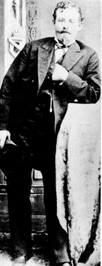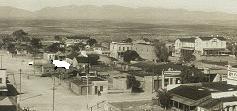
C. S. Fly
Encyclopedia
Camillus "Buck" Sydney Fly (2 May 1849 – 12 October 1901) was an American photographer most noted for the many photographs he took during Tombstone, Arizona
's wild and wooly days. He was also a lawman and served as Cochise County Sheriff from 1895 to 1897. His photos are legendary and highly prized.
. Shortly after Camillus' birth, they migrated to California
, eventually settling in Napa County.
In July, 1880, they opened a 12-room boarding house, and a separate studio called the “Fly Gallery” in the back of the boarding house located at 312 Fremont Street in Tombstone.
 On October 26, 1881, Fly was in a unique position, as the infamous Gunfight at the O.K. Corral
On October 26, 1881, Fly was in a unique position, as the infamous Gunfight at the O.K. Corral
actually took place in an alley between his boarding house and the next house west of it. During the shootout, Cochise County Sheriff John Behan took cover inside the boarding hourse, watching the gunplay, only to be joined by Ike Clanton
who fled in terror proclaiming he was unarmed. When the smoke cleared, it was Fly, armed with a Henry rifle
, who disarmed Billy Clanton as he lay dying against the house next door. If Fly ever took any photos of the scene of the shootout scene which was next to his own studio, they have been lost.
During this time, Fly and Mary adopted a little girl they called Kitty, but Mary continued to run the boarding house and studio as Camillus traveled around the area taking photographs. While her husband was out, she acted as one of the few female photographers of the times, taking pictures of anyone who could pay the studio price of 35 cents.
In March, 1886, Fly accompanied General George Crook to the Canyon de Los Embudos for the negotiations with Geronimo
. He became most famous for the photographs he took of the negotiations. His photos of Geronimo and the other free Apaches, taken on March 25 and 26th, are famous as the only existing photographs of a native American while still at war with the United states.
Fly had become a heavy drinker and the year after these famous photographs were taken, his wife Mary took their child and separated from her husband. He then left Tombstone on December 17, 1887 and toured Arizona with his photographs, briefly establishing a studio in Phoenix in 1893. However, the following year, he returned to the area. In the meantime, Mary continued to run the studio in Tombstone during his absence.
 Fly ranched in the Chiricahua Mountains
Fly ranched in the Chiricahua Mountains
, until his death at Bisbee
, on October 12, 1901. Though Camillus and his wife had been separated for years, she was at his bedside when he died, and made arrangements to have his body returned to Tombstone, where it was buried in the Tombstone Cemetery (this is the new Tombstone city cemetery, not the "old city cemetery" which became a legendary Boot Hill
).
Mary Fly continued to run the Tombstone gallery on her own and in 1905, she published a collection of her husband's Indian campaign photographs entitled "Scenes in Geronimo's Camp: The Apache Outlaw and Murderer." In 1912, the boarding house was the victim of a fire, which burned it completely (it has since been rebuilt). This incident prompted Mary to finally retire. Moving to Los Angeles, she donated her husband’s collection of negatives to the Smithsonian Institution in Washington, D.C. She died in 1925.
Tombstone, Arizona
Tombstone is a city in Cochise County, Arizona, United States, founded in 1879 by Ed Schieffelin in what was then Pima County, Arizona Territory. It was one of the last wide-open frontier boomtowns in the American Old West. From about 1877 to 1890, the town's mines produced USD $40 to $85 million...
's wild and wooly days. He was also a lawman and served as Cochise County Sheriff from 1895 to 1897. His photos are legendary and highly prized.
Early life
His parents were originally from Andrew County, MissouriAndrew County, Missouri
-External links:* from University of Missouri Division of Special Collections, Archives, and Rare Books...
. Shortly after Camillus' birth, they migrated to California
California
California is a state located on the West Coast of the United States. It is by far the most populous U.S. state, and the third-largest by land area...
, eventually settling in Napa County.
Tombstone, AZ
He married Mary “Mollie” E. Goodrich on September 29, 1879 in San Francisco. Mary, who was also a photographer, and Camillus soon moved to Arizona Territory, where they settled in Tombstone in December, 1879. Fly and his wife immediately set up a photographic studio in a tent before going to work on more permanent quarters.In July, 1880, they opened a 12-room boarding house, and a separate studio called the “Fly Gallery” in the back of the boarding house located at 312 Fremont Street in Tombstone.

Gunfight at the O.K. Corral
The Gunfight at the O.K. Corral was a roughly 30-second gunfight that took place at about 3:00 p.m. on Wednesday, October 26, 1881, in Tombstone, Cochise County, Arizona Territory, of the United States. Outlaw Cowboys Ike Clanton and Billy Claiborne ran from the fight, unharmed, but Ike's brother...
actually took place in an alley between his boarding house and the next house west of it. During the shootout, Cochise County Sheriff John Behan took cover inside the boarding hourse, watching the gunplay, only to be joined by Ike Clanton
Ike Clanton
Joseph Isaac Clanton was born in Callaway County, Missouri. He is best known for being a member of group of outlaw Cowboys that had ongoing conflicts with lawmen Wyatt, Virgil, Morgan Earp and Wyatt's friend Doc Holliday. The Clantons repeatedly threatened the Earps because they interfered with...
who fled in terror proclaiming he was unarmed. When the smoke cleared, it was Fly, armed with a Henry rifle
Henry rifle
The Henry repeating rifle was a lever-action, breech-loading, tubular magazine rifle.-History:The original Henry rifle was a .44 caliber rimfire, lever-action, breech-loading rifle designed by Benjamin Tyler Henry in the late 1850s. The Henry rifle was an improved version of the earlier Volcanic...
, who disarmed Billy Clanton as he lay dying against the house next door. If Fly ever took any photos of the scene of the shootout scene which was next to his own studio, they have been lost.
During this time, Fly and Mary adopted a little girl they called Kitty, but Mary continued to run the boarding house and studio as Camillus traveled around the area taking photographs. While her husband was out, she acted as one of the few female photographers of the times, taking pictures of anyone who could pay the studio price of 35 cents.
In March, 1886, Fly accompanied General George Crook to the Canyon de Los Embudos for the negotiations with Geronimo
Geronimo
Geronimo was a prominent Native American leader of the Chiricahua Apache who fought against Mexico and the United States for their expansion into Apache tribal lands for several decades during the Apache Wars. Allegedly, "Geronimo" was the name given to him during a Mexican incident...
. He became most famous for the photographs he took of the negotiations. His photos of Geronimo and the other free Apaches, taken on March 25 and 26th, are famous as the only existing photographs of a native American while still at war with the United states.
Fly had become a heavy drinker and the year after these famous photographs were taken, his wife Mary took their child and separated from her husband. He then left Tombstone on December 17, 1887 and toured Arizona with his photographs, briefly establishing a studio in Phoenix in 1893. However, the following year, he returned to the area. In the meantime, Mary continued to run the studio in Tombstone during his absence.
Sheriff Fly
Though his drinking was becoming more and more heavy, he was elected as the Cochise County Sheriff in 1895 and served for two years.Death

Chiricahua Mountains
The Chiricahua Mountains are a mountain range in southeastern Arizona which are part of the Basin and Range province of the southwest, and part of the Coronado National Forest...
, until his death at Bisbee
Bisbee
Bisbee may refer to:* Bisbee, Arizona* Bisbee, North Dakota* Bisbee Blue, turquoise from Bisbee, Arizona.* Bisbee Deportation, the illegal expulsion of 1,300 miners from Bisbee, Arizona...
, on October 12, 1901. Though Camillus and his wife had been separated for years, she was at his bedside when he died, and made arrangements to have his body returned to Tombstone, where it was buried in the Tombstone Cemetery (this is the new Tombstone city cemetery, not the "old city cemetery" which became a legendary Boot Hill
Boot Hill
Boot Hill is the name for any number of cemeteries, chiefly in the American West. During the 19th century it was a common name for the burial grounds of gunfighters, or those who "died with their boots on" ....
).
Mary Fly continued to run the Tombstone gallery on her own and in 1905, she published a collection of her husband's Indian campaign photographs entitled "Scenes in Geronimo's Camp: The Apache Outlaw and Murderer." In 1912, the boarding house was the victim of a fire, which burned it completely (it has since been rebuilt). This incident prompted Mary to finally retire. Moving to Los Angeles, she donated her husband’s collection of negatives to the Smithsonian Institution in Washington, D.C. She died in 1925.
Famous photos
- Tom McLaury, Frank McLaury, and Billy Clanton in their caskets after the Gunfight at the O.K. CorralGunfight at the O.K. CorralThe Gunfight at the O.K. Corral was a roughly 30-second gunfight that took place at about 3:00 p.m. on Wednesday, October 26, 1881, in Tombstone, Cochise County, Arizona Territory, of the United States. Outlaw Cowboys Ike Clanton and Billy Claiborne ran from the fight, unharmed, but Ike's brother...
, and also the only known photograph of Billy Clanton.
- Fly took this photo of Geronimo (far right) in March 1886, before his surrender to General Crook on September 4.
- Geronimo and Gen. Crook at Cañon de Los Embudos, Sonora, March 27, 1886.
External links
- http://www.legendsofamerica.com/law-camillusfly.html
- http://library.umkc.edu/spec-col/shadow-catchers/fly.htm

